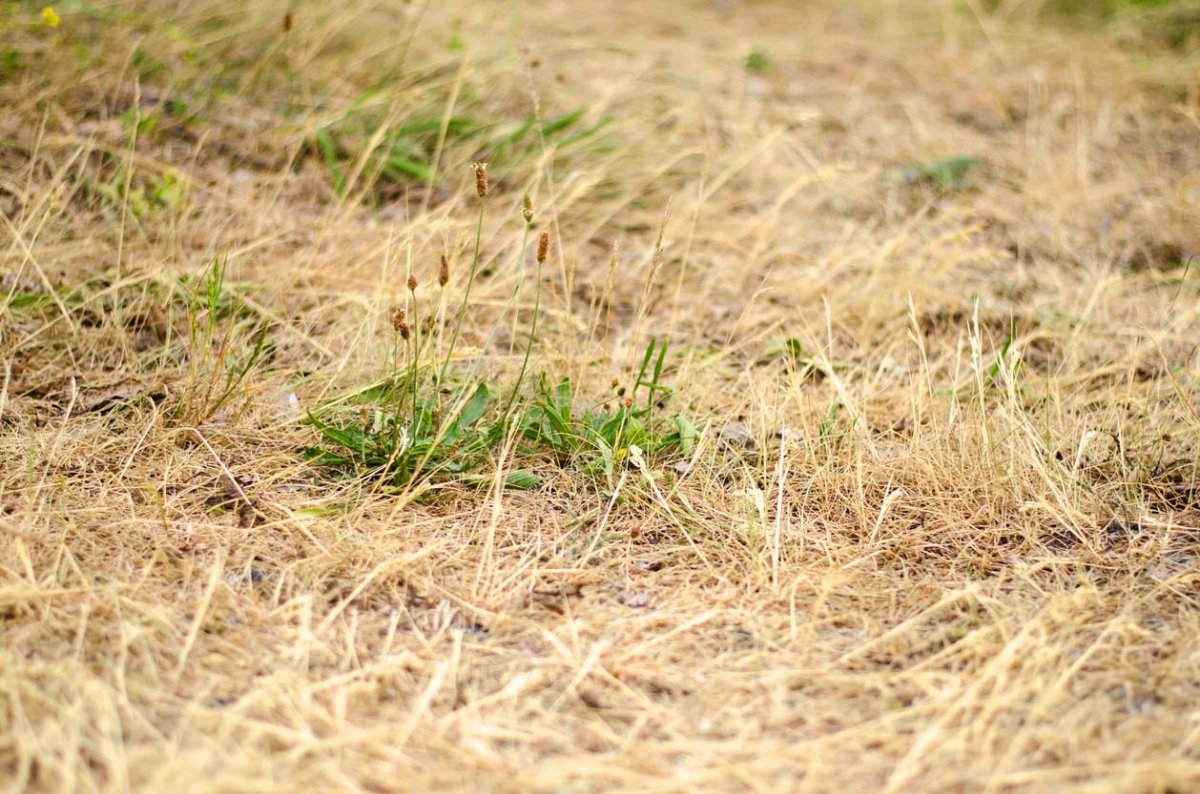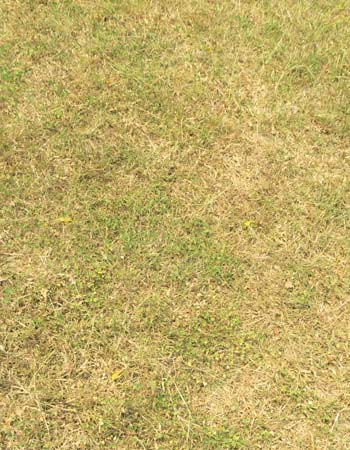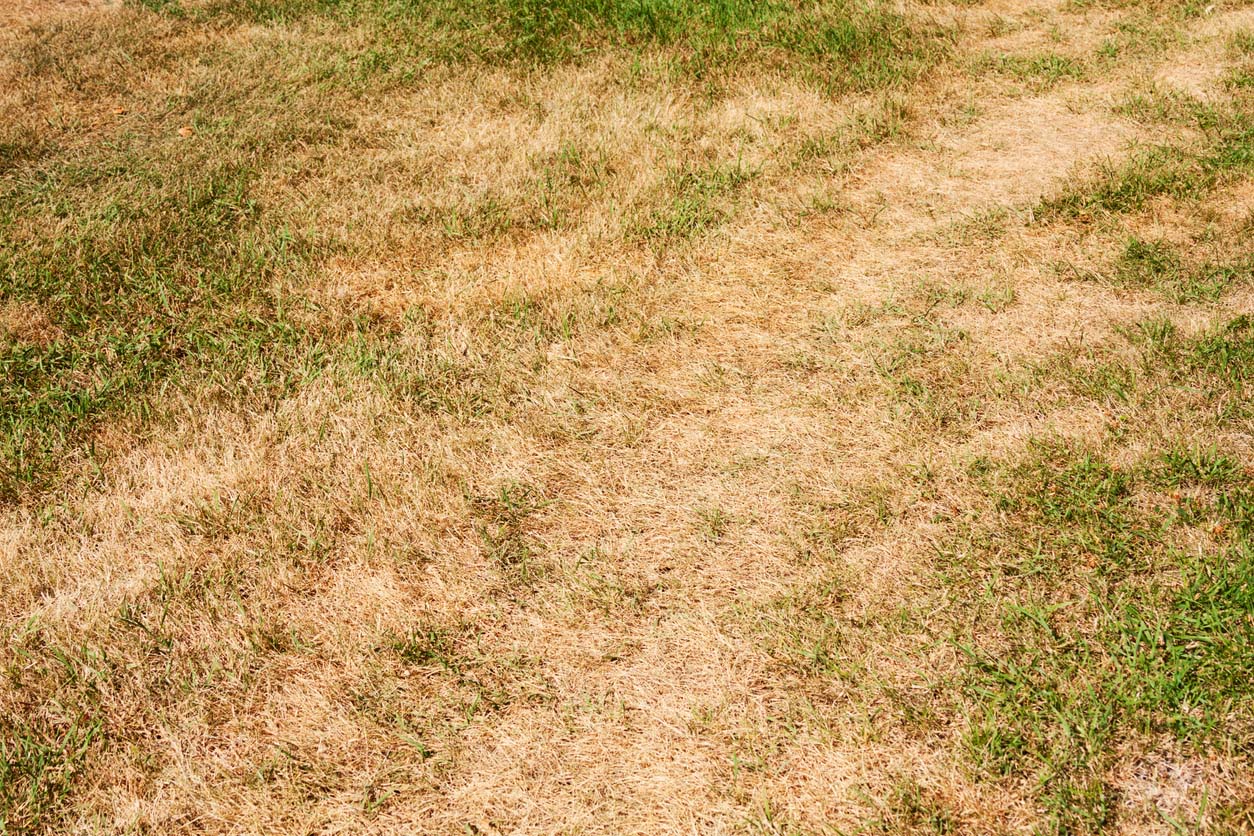

We may earn revenue from the products available on this page and participate in affiliate programs. Learn More ›
Q: I’ve been watering and mowing my lawn regularly, but I still see patches of dead grass. Why is my grass turning yellow, and what can I do? Can I treat the issue myself?
A: Maybe the Bermuda grass is turning yellow after a fertilizer application, or St. Augustine grass is turning yellow after weed-killer application. No matter the situation, it can be frustrating to see a lush, green lawn turn tan or yellow. When this happens, the yard could be experiencing a number of problems, from seasonal stressors to lawn diseases or compacted soil. For those who have tried multiple remedies and still find themselves wondering “Why is my grass turning yellow?” it may be time to enlist the help of a professional lawn specialist.

Low nutrient levels can cause grass to turn yellow.

Like other plants, grass requires certain elements to keep it healthy and allow it to grow. The grass could be lacking nutrients such as nitrogen, phosphorus, potassium, iron, magnesium, or oxygen. Of all the nutrients listed, nitrogen is the most essential to the health of the lawn since it is what gives the grass a lush green color. If grass is turning yellow in spring or summer, it may be time to supplement the lawn with fertilizer or other solutions that include a variety of nutrients to give it the support it needs to stay healthy.
Conversely, overfertilizing is also not beneficial for a lawn’s health and appearance.
Some believe that the more fertilizer applied to a lawn, the better the grass will grow. Unfortunately, this is not the case for most grass types. The best lawn fertilizer is tailored to the specific type of grass in a yard and has instructions for how much and how often to apply. Homeowners will want to choose a fertilizer that suits their needs, goals, and application preferences. In general, the best option is to spread fertilizer in equal proportions across the lawn so that one spot doesn’t become oversaturated with nutrients.
If it’s too late and copious amounts of granular fertilizer have already been applied to the grass, a homeowner can attempt to scoop up excess granules with a shovel. If liquid fertilizer was used, it might be possible to rinse the soil with water throughout the week to prevent fertilizer burn and remove any buildup. It’s best to then wait a few weeks to see if the yard has recovered; if not, a homeowner may need to reseed the lawn.
Improper fertilizer application can lead to grass blades turning yellow.
Fertilizers often contain soluble salts, which, when applied incorrectly, can build up and cause grass to turn yellow. This is especially the case with fast-acting liquid fertilizers. Applying too much fertilizer to one area, not properly diluting the fertilizer, or applying it with the wrong tool can mean the product is dispersed unevenly, which can lead to yellow or bare spots in a lawn. As soon as any yellow or tan patches are spotted, homeowners can try to water them for about a week to flush out the salt. After a few weeks, if the grass hasn’t turned green, it may be necessary to dig up and reseed the yellow areas.
Yellow grass can be caused by overwatering or underwatering.
Homeowners may think that the more the lawn is watered, the better condition it will be in. Unfortunately, overwatering the yard can drown grass roots and lead to less oxygen in the soil, which is essential for healthy, green grass. On the other hand, not watering grass enough can create drought-like conditions that cause the grass to yellow or die altogether.
If yellow grass is already present due to overwatering or underwatering, it’s possible it can be brought back to life; sometimes all that’s necessary is adjusting the amount of water sprayed on the grass or the watering frequency. It helps to just focus on the yellow patches and water when temperatures are lower and the sun isn’t at its peak. Most mature lawns only need about an inch to 1½ inches of water per week.
Lawn diseases and pests can make grass turn yellow.
There’s a chance that the grass turning yellow has nothing to do with the treatment of it and everything to do with the insects or diseases that can take over a yard. If small holes are present in grass blades, it could be a sign that insects such as caterpillars, beetle grubs, or worms are feeding on the roots of the grass and killing it from underneath the ground.
When no sign of insect infestation is apparent, potential diseases such as mold or fungus could be the culprits, which can also turn grass yellow. Common lawn diseases include:
- Dollar spot: Lawn patches are small, circular, and sunken, and individual blades may have white spots.
- Fairy ring: Circular rings of dark green and dead grass are present, and mushrooms may also be present.
- Take-all root rot: Grass roots are short, rotted, and black.
- Brown patch: Rings or circular patches of brown grass are present, and blades may have gray or brown spots.
- Large patch: Rings or circular patches of brown grass are present, but there are no lesions on the leaves.
- Rust: Grass blades have a yellow to orange substance on them that is easily rubbed off.
- Leaf spot or melting out: Leaves will have dark spots surrounded by a yellow ring.
- Gray leaf spot: Brown to gray oval-shaped leaf spots are present; this typically occurs on St. Augustine grass in the summer.
- Anthracnose: Reddish-brown leaf spots with a yellow halo are present.
- Slime mold: Slimy or crusty balls the size of pinheads are present; they are easily removed from the grass.
- Pythium root rot: Mottled leaves of grass are present, and the lawn is slow-growing.
A homeowner can get rid of fungus on the lawn by switching up the watering routine, removing grass clippings after mowing, or applying fungicide in the patches affected by the disease.
Dog urine can create yellow spots in a lawn.
While we want our canines to do their business outside, urine that sits too long on the grass can lead to yellow spots. These patches are the result of ammonia and other chemicals released with the urine that can cause dead spots in a yard. The good news is that dog pee turning grass yellow can be treated with horticultural lime and some water. This solution can be purchased at local home improvement stores and can revive yellow spots so long as the manufacturer’s instructions are adhered to and the homeowner waters the area after application.
The spot should turn bright green after treatment, but if the area doesn’t improve within a few weeks, it may be time to dig out the dead grass and reseed the lawn.

Compacted soil can cause grass to appear yellow or brown.
Grass that is repeatedly walked or driven on can cause soil to become compacted, which eliminates the space between the soil for oxygen, water, and other necessary nutrients. Using the same path for walking, driving, or biking can lead to yellow or brown strips that have a harder time staying healthy because the supply chain of nutrients the grass relies on to grow is no longer present. Homeowners can attempt to bring those areas back to life by adding compost to the lawn, aerating the soil, or enlisting the help of one of the best lawn care services to assess and treat the soil.

Seasonal stressors can be the cause of a yellowing lawn.
When temperatures climb or dramatically fall, the exposure to harsh conditions such as full sun or snow and ice can cause the grass to turn yellow. And depending on what type of grass is present, it’s likely to go into a dormant state during the summer or winter seasons in order to protect itself from extreme heat or cold. In some cases, a yellowing lawn could even be the result of residual salt used on icy sidewalks or driveways.
“By the end of the summer, grass that has been overexposed to consistent heat and drought may have to enter a dormant state just to survive until the next spring,” said Frank Rossi, chief science officer at Sunday Lawn Care. “This grass will look grayish and then eventually brown or straw colored.” While it may not be what a homeowner wants it to look like, this process is normal, and a homeowner can maintain a solid lawn-care routine to minimize the chances of a lawn getting stressed during seasonal shifts.
FAQs
Whether they’re curious about the condition of the grass in different seasons or want to know which fertilizer to use, homeowners can find answers to all of their burning lawn questions below.
Q. Why is my grass turning yellow in summer?
Excessively hot weather and exposure to full sun throughout the day causes a lawn to dry out and turn yellow in warmer seasons.
Q. Why is my grass turning yellow in winter?
In colder months, grass goes into a dormant state and turns yellow to protect itself from harsh conditions such as snow or ice.
Q. Why is my grass turning yellow over my drain field?
Yellow strips of grass over a drain field could be a sign of a leaking septic leach line or a result of drying out from warm temperatures.
Q. Why is my new grass turning yellow?
If cut too short, new grass will turn yellow due to lack of moisture. It’s best to let the grass grow longer before cutting it so it retains water and stays green.
Q. What is the best fertilizer for yellow grass?
It depends on the soil. You can send a soil sample to a local cooperative extension or to one of the best DIY lawn-care programs to get a recommendation for the right fertilizer. For example, Sunday will test your soil before prescribing a lawn-care treatment plan.
Q. Why is my grass turning yellow even after watering?
You may be overwatering the lawn, which can cause yellow patches.
Q. Does grass turn yellow with too much water?
It can. Overwatering drowns the roots of the grass and removes necessary oxygen from the soil, which can lead to yellowing.
Q. Is it normal for grass to turn yellow in summer?
Yes, especially for those who live in a warm climate. Heat can put stress on a lawn, and exposure to full sun for hours at a time can dry out the grass.
